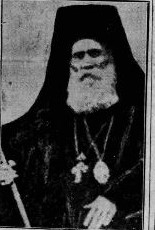
Germanus I of Constantinople was the Ecumenical Patriarch of Constantinople from 715 to 730. He is regarded as a saint by both the Orthodox and Catholic Churches, with a feast day of 12 May. He had been ecumenically preceded by Patriarch John VI of Constantinople, and was succeeded in Orthodox Rite by Patriarch Anastasius of Constantinople.
John Scholasticus or Scholastikos was the 32nd patriarch of Constantinople from 12 April 565 until his death on 31 August 577. He is also regarded as a saint of the Eastern Orthodox Church.
Fravitta of Constantinople, also known as Fravitas, Flavitas, or Flavianus II, was the patriarch of Constantinople (489–490).

John IV of Constantinople, also known as John Nesteutes, was the 33rd Patriarch of Constantinople. He was the first to assume the title Ecumenical Patriarch. He is regarded as a saint by the Eastern Orthodox Church which holds a feast on 2 September.

Benjamin I was Ecumenical Patriarch of Constantinople from 1936 to 1946.

Kyros of Constantinople was the Ecumenical Patriarch of Constantinople from 705 to 711. He is regarded as a saint in the Eastern Orthodox Church and Catholic Church, which had set his feast for 7 January in Catholic Church and 8 January (21) in Orthodox Church. Kyros was placed on the patriarchal throne in 705 by Emperor Justinian II, as a replacement for the deposed Patriarch Callinicus I of Constantinople. Soon after Justinian's decline and eventual fall in December 711, Kyros was replaced by the new Emperor Philippicus with Patriarch John VI of Constantinople, who shared Philippicus' Monothelite sympathies.
John VI of Constantinople was the Ecumenical Patriarch of Constantinople from 712 to 715. He had been preceded by Patriarch Kyros of Constantinople. He was in all sanctification, succeeded by His All Holiness Germanus I of Constantinople.
John V of Constantinople was the Ecumenical Patriarch of Constantinople from 669 to 675. He had ecumenically been proceeded by Thomas II of Constantinople. It was during his patriarchate time that the distressing first Siege of Constantinople (674–678) was undertaken by the rigid Umayyad Caliphate (661–750) began. He was emphatically succeeded by Constantine I of Constantinople.

Constantine I of Constantinople was the patriarch of Constantinople from 675 to 677. He is listed as a saint, feast day 29 July. He was preceded by John V of Constantinople. He was succeeded by Theodore I of Constantinople.

The Patriarchate of Cilicia is an ecclesiastical jurisdiction and the only patriarchate of the Armenian Catholic Church of the Catholic Church. The territorial jurisdiction of the Patriarch of Cilicia is the Archeparchy of Beirut, over which the Patriarch of Cilicia holds ordinary authority. The St. Elie and St. Gregory the Illuminator Armenian Catholic Cathedral in Beirut, Lebanon, is the cathedra of the Patriarchate. The Patriarchate is headed by Patriarch Raphaël Bedros XXI Minassian elected in September 2021.
Isidore I of Constantinople was the Ecumenical Patriarch of Constantinople from 1347 to 1350. Isidore was a disciple of Gregory Palamas.
Theodotus of Antioch, patriarch of Antioch, in 420 succeeded Alexander, under whom the long-standing schism at Antioch had been healed, and followed his lead in replacing the honoured name of John Chrysostom on the diptychs of the church. He is described by Theodoret, at one time one of his presbyters, as "the pearl of temperance", "adorned with a splendid life and a knowledge of the divine dogmas". John Moschus relates anecdotes illustrative of his meekness when treated rudely by his clergy, and his kindness on a journey in insisting on one of his presbyters exchanging his horse for the patriarch's litter. By his gentleness he brought back the Apollinarians to the church without rigidly insisting on their formal renouncement of their errors. On the real character of Pelagius's teaching becoming known in the East and the consequent withdrawal of the testimony previously given by the synods of Jerusalem and Caesarea to his orthodoxy, Theodotus presided at the final synod held at Antioch at which Pelagius was condemned and expelled from Jerusalem and the other holy sites, and he joined with Praulius of Jerusalem in the synodical letters to Rome, stating what had been done. The most probable date of this synod is that given by Karl Josef von Hefele: 424. When in 424 Alexander, founder of the order of the Acoemetae, visited Antioch, Theodotus refused to receive him as being suspected of heretical views. His feeling was not shared by the Antiochenes, who, ever eager after novelty, deserted their own churches and crowded to listen to Alexander's fervid eloquence. Theodotus took part in the ordination of Sisinnius I of Constantinople as patriarch of Constantinople, in February 426, and united in the synodical letter addressed by the bishops then assembled to the bishops of Pamphylia against the Massalian heresy. He died in 429.
Maximus IV, previously known as Manasses (Μανασσῆς), was an Orthodox Christian monk and bishop. He was Ecumenical Patriarch of Constantinople from 1491 to 1497.
Christianity is an Abrahamic monotheistic religion based on the life and teachings of Jesus as interpreted in the Bible. It is the largest religion in the world, with 2.4 billion people, known as Christians, that adhere to the religion.
Hovhannes XII Arsharuni was an Armenian Patriarch of Constantinople.
Patriarch John may refer to:
Patriarch John of Constantinople may refer to:
This page is based on this
Wikipedia article Text is available under the
CC BY-SA 4.0 license; additional terms may apply.
Images, videos and audio are available under their respective licenses.





